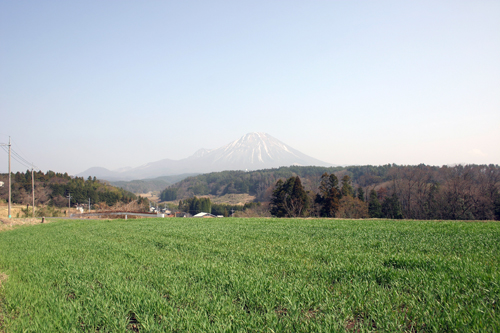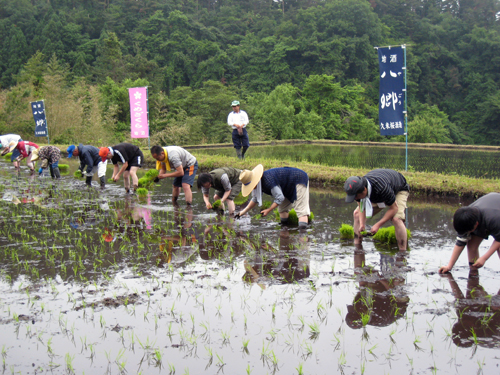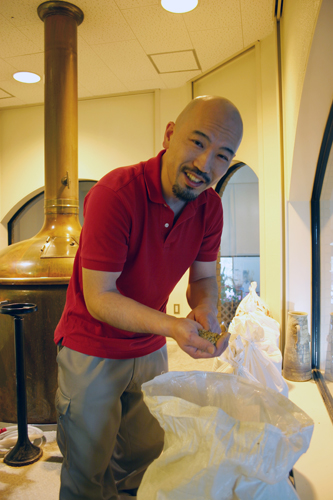
by Kumagai Jinya
When you look out from Tottori prefecture’s government offices in Yonago City, a majestic mountain much in the shape of Mt. Fuji grabs your attention.
Locally known as Hôkifuji, its official name is Daisen, at the foot of which Daisen G Beer produces its brews. These are a brand of Kumezakura Bakushu, Inc. which is a joint venture between San-in Sanso Corporation, a vendor of high-pressured gas, and Kumezakura Shuzô, the original sake brewery established in 1856. The company began producing and marketing beer in 1997.
Daisen G Beer’s head brewer is Hideki “Hide” Iwata. He graduated from Shimane University’s department of agriculture having studied applied microbiology with an eye to researching at a sake brewery. Just prior to graduating, however, he learned that Kumezakura would begin making beer. Honing the existing techniques at a sake brewery was certainly a noble pursuit, but making beer offered greater variables and less established technique. He began to wonder if he weren’t better suited to pursuing something new like that, and in the end helped launch Daisen G Beer.
The Daisen area has rich natural surroundings. Its water, in particular, is a blessing. Water used during brewing is sourced near the brewery and is the same as that from the Jizôtaki spring, which was named one of the Heisei Era’s (1989~) top 100 springs. It has a very mild taste with a hint of sweetness. It’s said that the rain and snow that falls on Daisen percolates for 400 years before welling up in the spring. The soft murmur of the spring is enough to make you lose your sense of time. Iwata, who shows me around, reveals a kind of affection toward this resource, “Simply listening to the water is pleasant, isn’t it? This is where I always want to be.”
Daisen’s dirt, too, is rich. Completely black, fertile soil called “kuroboku” stretches around the mountain, the result of volcanic ash and humus. The company utilizes this soil to produce three crops. The first is Daisen Gold, a type of barley harvested in the early summer whose production they revived after a hiatus; the second is hop in the summer; and the third is Yamadanishiki, a sake rice harvested in the fall that they also use to make beer. Basically, except for when the area is blanketed in snow, you can see them cultivating one of these three products.
I had heard that Daisen G beer began hop cultivation in front of their brewery after being inspired by Shiga Kogen Beer (featured in the previous issue), but the sharp rise in hop prices in recent years was also a big factor. The area around Daisen had never grown hops before and people muttered, “probably won’t work.” Nevertheless, they got some advice from Shiga Kogen and tried it anyway. The first year they planted 40 bines but only three of them bore hop cones. The second year, they planted 80, with six bearing cones, but insects got to them and they couldn’t harvest much. They absolutely wanted to stick with organic farming so in their third year, they picked the pests away by hand. Then some local farmers taught them a neat trick: mix habanero, cayenne pepper and garlic into some wood vinegar as a repellent. With that they were finally able to harvest enough hops to brew some beer.
They coined this homemade variety Weihen Hop, named affectionately after the German word Weihen, meaning to consecrate or dedicate. The hop garden was previously a plum grove and the name seemed fitting. This year marks the fifth year of cultivation and they now having 20 bines each of Cascade, Centennial, Chinook and Sterling that they hope will produce as much as 30kg of hop.
The Yamadanishiki sake rice is used in their “Yagô.” This beer, being brewed for the sixth time this year, is marked by a fruity aroma and subtly sweet flavor. Yagô is the name of the area around the production facilities where the rice is cultivated.
With this experience in agriculture, Iwata asserts, “Now more than ever I’ve come to see that I want to brew with raw ingredients like this. No joke—I took care of the hops every day until I was exhausted. But it’s also refreshing in a way, and is work that makes you feel good.” Revealing the deeper charm of growing hops, he continues, “Beer made with hops cultivated like this is simply going to taste good. No doubt. Watching over it as it grows above you is exhilarating.” While Iwata also professes a steadfast love for the mountain, it’s in how he talks about the hop that you sense where he wants to go.
The Daisen G Beer brand launched with three beers, a pilsner, brown ale and weizen, with the brown ale giving way to pale ale. Wanting to add a dark beer to the line-up, Iwata brewed an imperial stout whose deliciousness he gets giddy over. An easier-to-drink stout was then born from this (though it’s actually a porter).
When considering his first limited-edition beer, he originally wanted to make a Dunkel. At the time, he was receiving some direction on technique from an employee of one of the big beer makers, who advised, “Don’t focus on the style name; give priority to the character of beer you want to make.” Iwata took it to heart, brewing over 50 different kinds of limited-edition beer to achieve the various flavors he wanted. The experience he derived from these endeavors has also improved the quality of his flagship beers. In some cases, he simply tweaked the original recipes, changing just the yeast for example. Iwata was then able to convey those subtle differences directly to the drinker.
Iwata relates with more emotion than usual his initial experience with barley wine, “It was the first time I had aged a beer and it came out tasting great; it was a feeling like I had grown into adulthood–or even like I had joined a circle of exceptional brewers in Japan.”
From that moment on, Iwata realized that the taste of Daisen G beer had evolved. And in truth, its sales increased not only at the brewery’s restaurant, but also at their retailers. Then in 2010 he made a wheat wine using the same recipe as his barley wine, just adding some wheat. This was arguably the most impressive beer of any he had ever made. “I only changed one part of the process, but the aroma changed completely. The moment I entered the brewery the day we were brewing, I knew that we had brewed something good.”
Iwata places emphasis on making beer with “gentle flavor”. “Daisen’s color, to give an example, is white. I personally associate white with milk. I want that smoothness of milk imparted in my weizen. I crafted this popular weizen with feedback from customers since the time we were established, so I was quite happy when it won the award at the World Beer Awards in 2011.” At this competition held in England every year, judges decide the best of each category. Daisen G Beer won in the weizen category. There is no second place. When Iwata announced the award to fans, he said, “I didn’t really make this beer, but am still very happy.” How serious is Iwata about his weizen? “I grow my trademark mustache to look like foam on the lip after quaffing a weizen!”
With the recent groundswell of support for craft beer in Japan, Iwata’s aspirations continue to grow. “Although the volume of beer we produced across the board increased, with the WBA award in 2011, we had to produce 300% more weizen over the following year. I had thought we would break another 100% increase in 2013, but at this current rate, we’ll increase production by 120%. To meet our targets we had to brew through the winter, which was never our strong suit, but conversely we’ve managed to overcome our weaknesses.”
There are now more than a few beer bars in the big cities that carry Daisen G Beer. But if you really want a taste of the good stuff, then definitely visit their brewery restaurant, “Bier Hof Gambarius.” Recently, they’ve been filling to capacity so you’re advised to make reservations. On June 8th and 9th, they are once again hosting “Ji-Beer Fest Daisen,” which features beer, food and music. The campgrounds are free to use at this time, allowing festival goers to come by car and sleep there. Then on the 10th, they participate in the San-in Craft Beer Festival in Yonago. Sounds like a trip to that side of Japan is in order!


This article was published in Japan Beer Times # () and is among the limited content available online. Order your copy through our online shop or download the digital version from the iTunes store to access the full contents of this issue.



